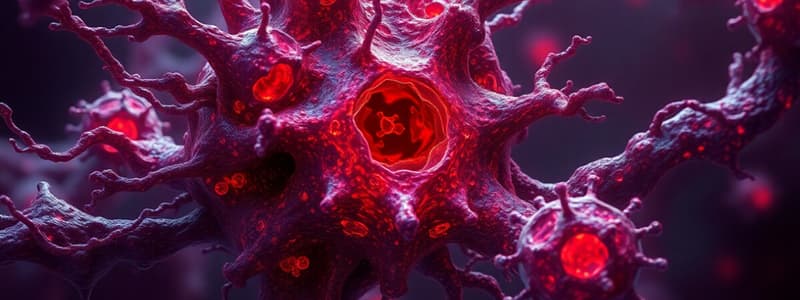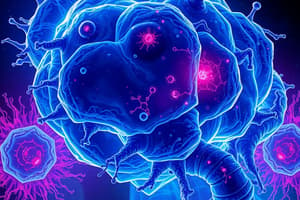Podcast
Questions and Answers
What is the term for a reduction in an organ's size due to a decrease in stress, nutrients, or blood supply?
What is the term for a reduction in an organ's size due to a decrease in stress, nutrients, or blood supply?
Atrophy
What is the process called when a decrease in cell number occurs in atrophy?
What is the process called when a decrease in cell number occurs in atrophy?
- Hypertrophy
- Hyperplasia
- Necrosis
- Apoptosis (correct)
A decrease in the size and number of cells is not a characteristic of atrophy.
A decrease in the size and number of cells is not a characteristic of atrophy.
False (B)
What is the term for the process of a cell changing its type in response to stress?
What is the term for the process of a cell changing its type in response to stress?
Metaplastic cells are typically less able to handle new stress.
Metaplastic cells are typically less able to handle new stress.
Give a classic example of metaplasia.
Give a classic example of metaplasia.
What is the term for an increase in the size of an organ due to an increase in the size of its cells?
What is the term for an increase in the size of an organ due to an increase in the size of its cells?
Hyperplasia refers to an increase in the number of cells and can only occur in tissues that contain labile cells.
Hyperplasia refers to an increase in the number of cells and can only occur in tissues that contain labile cells.
Flashcards
What is atrophy?
What is atrophy?
A decrease in organ size due to a decrease in the size and number of cells.
What is a key mechanism of atrophy?
What is a key mechanism of atrophy?
A decrease in cell size, often involving degradation of cellular components.
What is ubiquitin-proteosome degradation?
What is ubiquitin-proteosome degradation?
A cellular process involving the tagging of proteins for breakdown by proteasomes.
What is autophagy?
What is autophagy?
Signup and view all the flashcards
What is metaplasia?
What is metaplasia?
Signup and view all the flashcards
What type of epithelium lines the normal esophagus?
What type of epithelium lines the normal esophagus?
Signup and view all the flashcards
What type of epithelium lines the esophagus after metaplasia?
What type of epithelium lines the esophagus after metaplasia?
Signup and view all the flashcards
Can metaplasia be reversed?
Can metaplasia be reversed?
Signup and view all the flashcards
What can happen if metaplasia in the esophagus persists?
What can happen if metaplasia in the esophagus persists?
Signup and view all the flashcards
What is an example of metaplasia that is not associated with increased cancer risk?
What is an example of metaplasia that is not associated with increased cancer risk?
Signup and view all the flashcards
What is keratomalacia?
What is keratomalacia?
Signup and view all the flashcards
What is myositis ossificans?
What is myositis ossificans?
Signup and view all the flashcards
What is dysplasia?
What is dysplasia?
Signup and view all the flashcards
What is cervical intraepithelial neoplasia (CIN)?
What is cervical intraepithelial neoplasia (CIN)?
Signup and view all the flashcards
Where can dysplasia arise from?
Where can dysplasia arise from?
Signup and view all the flashcards
What is aplasia?
What is aplasia?
Signup and view all the flashcards
What is hypoplasia?
What is hypoplasia?
Signup and view all the flashcards
What is unilateral renal agenesis?
What is unilateral renal agenesis?
Signup and view all the flashcards
What is streak ovary in Turner syndrome?
What is streak ovary in Turner syndrome?
Signup and view all the flashcards
What causes atrophy?
What causes atrophy?
Signup and view all the flashcards
How is cell number reduced during atrophy?
How is cell number reduced during atrophy?
Signup and view all the flashcards
What is the mechanism of cell size reduction in atrophy?
What is the mechanism of cell size reduction in atrophy?
Signup and view all the flashcards
What is hypertrophy?
What is hypertrophy?
Signup and view all the flashcards
What is hyperplasia?
What is hyperplasia?
Signup and view all the flashcards
Are hypertrophy and hyperplasia related?
Are hypertrophy and hyperplasia related?
Signup and view all the flashcards
What is an example of permanent tissue?
What is an example of permanent tissue?
Signup and view all the flashcards
What triggers growth adaptations?
What triggers growth adaptations?
Signup and view all the flashcards
What are the two main types of growth adaptations?
What are the two main types of growth adaptations?
Signup and view all the flashcards
What is the key feature of hypertrophy?
What is the key feature of hypertrophy?
Signup and view all the flashcards
What is the key feature of hyperplasia?
What is the key feature of hyperplasia?
Signup and view all the flashcards
Study Notes
Atrophy
- A decrease in stress (e.g., decreased hormonal stimulation, disuse, or decreased nutrients/blood supply) leads to a decrease in organ size (atrophy).
- Occurs via a decrease in the size and number of cells
- Decrease in cell number occurs via apoptosis.
- Decrease in cell size occurs via ubiquitin-proteasome degradation of the cytoskeleton and autophagy of cellular components.
- In ubiquitin-proteasome degradation, intermediate filaments of the cytoskeleton are "tagged" with ubiquitin and destroyed by proteasomes.
- Autophagy of cellular components involves generation of autophagic vacuoles.
- These vacuoles fuse with lysosomes whose hydrolytic enzymes breakdown cellular components.
Studying That Suits You
Use AI to generate personalized quizzes and flashcards to suit your learning preferences.




